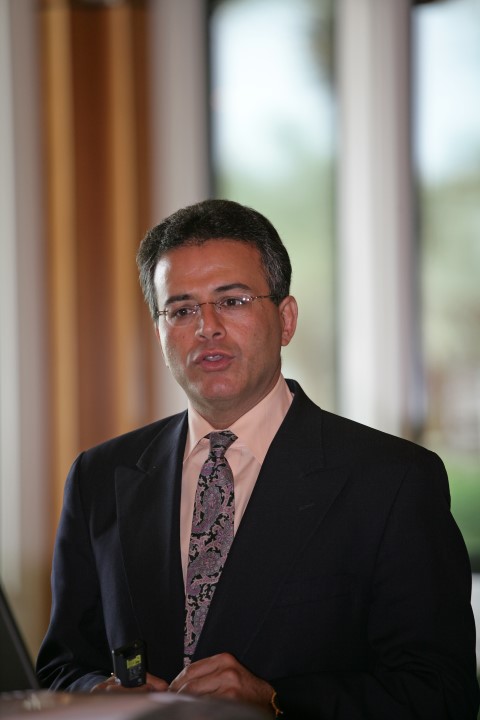Dialogue Series, Regional Studies
Presidential Elections in Iran by Mehrzad Boroujerdi

CIRS hosted a discussion on the Iranian presidential elections on June 14, 2009, featuring Dr. Mehrzad Boroujerdi, an Associate Professor of Political Science at the Maxwell School of Citizenship and Public Affairs at Syracuse University. Professor Boroujerdi is engaged in a broad, empirical study of the Iranian political elites. Guests included a number of ambassadors and diplomats resident in Qatar, educational experts from Qatar University, as well as Georgetown University faculty.
Boroujerdi began by framing the current elections and their results within a historical perspective, before proceeding through an analysis of what happened in Iran on June 12th 2009, the subsequent public reaction to the results, and what impact this might have on the future shape of the Iranian political system.
Through graphs and other statistical evidence Boroujerdi highlighted particular trends from previous Iranian presidential elections, the novel features of this particular election, as well as statistical data necessary for determining the legitimacy of the current election results.
Boroujerdi pointed out that despite the role of the president being limited in Iran’s political structure, the ten elections held for the position since the revolution have been actively contested. In the early days of the revolution, the requirements for being eligible to run for the office were low, but in more recent years the ruling elites, and in particular the Supreme Leader, have strictly limited the number of eligible candidates to the cream of the crop.
Boroujerdi felt that there was little chance that President Ahmedinejad was the genuine winner of the elections with the announced margin of victory.
In order to address the question of why so many people are suspicious of the election results, Boroujerdi presented a series of graphs of the figures just released by the Iranian Election Commission. According to the data given out by the Commission, this last presidential election has been the most popular election since the revolution, with over 82 percent of all eligible voters casting their ballots. This is a significant jump from the previous percentage of four years ago, and is even greater than the elections of 1997, which up until then had been the most popular election. Voter participation in the presidential election in Iran to the tune of around 60 percent is considered the norm, so experts on Iranian politics determine that the given numbers for this year are abnormally high.
Furthermore, elections where one of the candidates is a sitting president have historically been less popular with Iranian voters, due to the public’s perception that the incumbent has the strong advantage of retaining his seat. Three times in Iran’s recent history, on the occasions where Presidents Khamana’i, Rafsanjani, and Khatami were running for a second term there was a significant drop in voter turn-out. If the numbers are to be trusted for the current election, they not only indicate that the voter percentage is the highest in the history of post-revolutionary elections, but also that there has been a substantial increase in voter turn-out since the elections of four years ago.
Causing further skepticism regarding the authenticity of the 2009 election results is the fact that in all the previous elections candidates were able to usually win at least a single province, and most likely the one that they originate from. In the current election that did not happen. Several of the running candidates did not win the majority of the votes from their provinces.
Important issues in these elections were the economy and the staggeringly high unemployment and inflation rates. Corruption in the government, as well as the international isolation of the country were also hotly contested issues which each of the candidates spoke to. Despite the economic woes of the country, the other candidates in this election were unable to form any clear and coherent economic platforms to counter President Ahmadinejad’s.
Boroujerdi noted that the 2009 Iranian presidential elections demonstrated some novel features previously unseen in Iranian post-revolutionary politics. Amongst other things, these included the active role of the media, especially alternate and internet media; the positions adopted by the various clerical parties; and the phenomena of placing a candidate’s wife under public scrutiny. It was also the first time in Iranian presidential elections that a previous president who had completed two terms in office attempted to run for a third before pulling out of the campaign.
Boroujerdi noted that the active participation, involvement and energy seen in the Iranian public throughout this election and following it, is unprecedented in post-revolutionary Iran. It is a clear indication that the will for a more participatory political system is extremely strong and alive in the Iranian state.